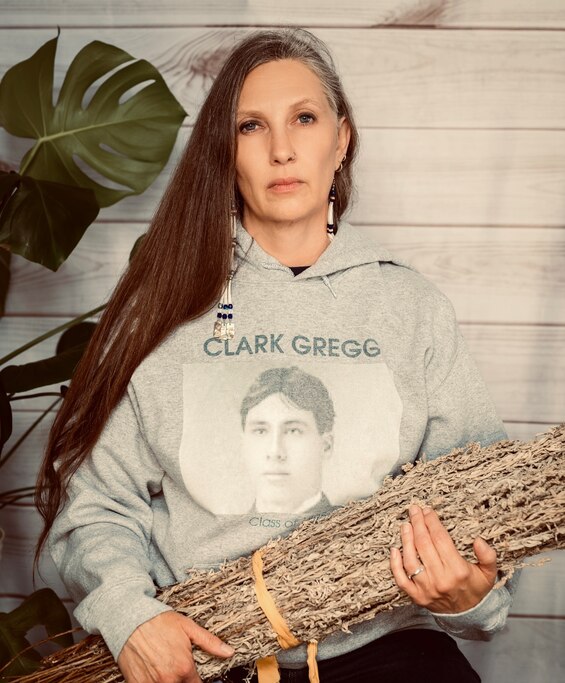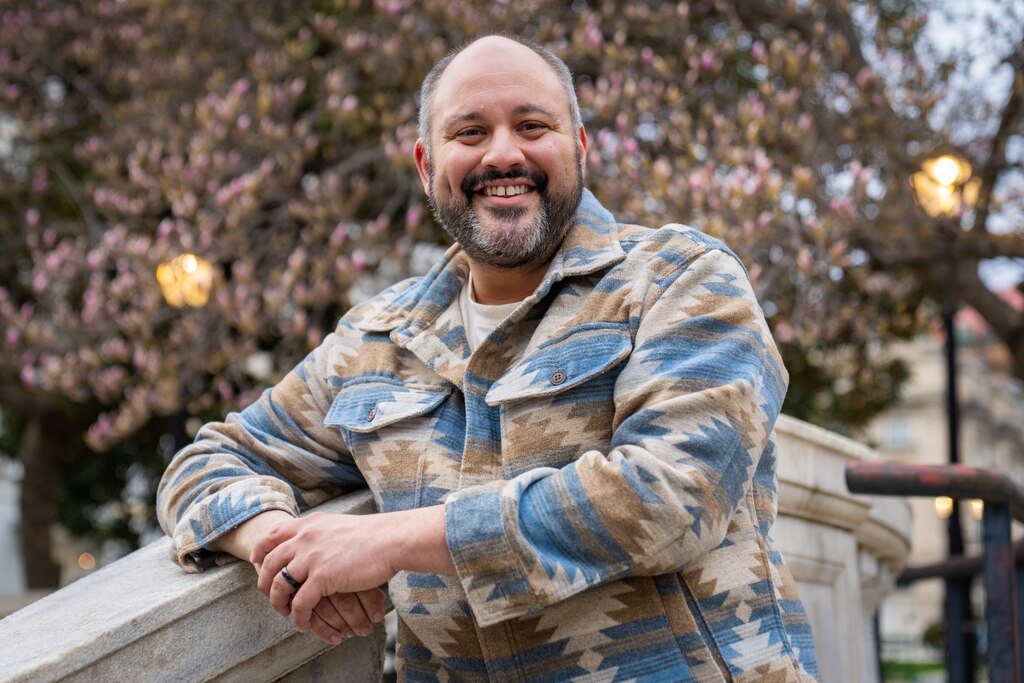Derek Chavis sat on his living room couch in January and was moved to tears watching actress Lily Gladstone speak at the Golden Globes Awards.
Even though he did not understand the Blackfoot language that the “Killers of the Flower Moon” star spoke in accepting the best actress award, the sight of an Indigenous woman proudly speaking in her Native dialogue was inspiring to the Mount Vernon resident, who is a descendant of the Lumbee Tribe.
“I’m tearing up now thinking about it,” said Chavis, 38, a Baltimore City school history teacher. “It’s a joyful tear up. I’m not one of those people. I’m glad that others are doing their thing. And maybe this is the start.”
Chavis has been enjoying the moment as Indigenous characters and storylines have been featured in critically acclaimed shows and movies such as Disney’s “Echo,” Hulu’s “Reservation Dogs” and “Prey,” Paramount Plus’ “1923,” and HBO’s “True Detective: Night Country.” The variety of productions has showcased the diverse, rich spectrum of Indigenous culture, with many featuring Indigenous languages.
The Baltimore Banner thanks its sponsors. Become one.
Gladstone is nominated for best actress at the 96th Annual Academy Awards, being held Sunday night.
And yet the films and TV shows also serve as a harsh reminder of the struggle that Chavis’ people and other Indigenous groups have endured in this country. For starters, the Lumbee are not a federally recognized tribe. And for a variety of reasons, from the systemic to geographic, tribes along the East Coast, which had the earliest contact with colonizers, were more likely to assimilate — they do not actively speak a native tongue.
“The Lumbee language is dead,” Chavis lamented. “Not having that from my ancestors played a really big part of my whitewashing growing up.”
Dave LaSarte-Meeks, executive director of the Vadon Foundation, a Seattle, Washington-based advocacy group that supports Indigenous community-based initiatives, explained that Indigenous languages have been “deliberately destroyed” by government policy in the United States and across the world.
“A cornerstone to their approach is to destroy the people or what made them people,” said LaSarte-Meeks, 52. He is a member of the Coeur d’Alene Tribe. Their name in their native language is Schitsu’umsh, which translates to “the discovered people.”
The Baltimore Banner thanks its sponsors. Become one.
“Destroying the languages, you destroy the culture and the people,” said LaSarte-Meeks, who explained that after his grandparents attended mission schools, they returned to their families not knowing how to speak their native dialect.
“It’s not ancient history,” he said.
Indian boarding schools were founded by the U.S. government or Christian missions to eliminate traditional American Indian ways of life and replace them with mainstream American culture, according to the National Museum of the American Indian. Thousands of Indigenous children were stripped from their families and forced to attend these schools beginning in the late 19th century.
In addition to being separated from their families — and native tongues — these children were beaten, starved and punished when they spoke their Native languages.
Although exact numbers are not known, by 1925, an estimated 60,889 Indigenous children were in boarding schools, according to the National Native American Boarding School Healing Coalition.
The Baltimore Banner thanks its sponsors. Become one.
Between 1870 and 1950, the U.S. government spent $2 billion on the boarding school systems, according to Wilhelm Meya, former CEO of The Language Conservancy, who described this as a “huge tipping point” for Indigenous languages.
“By and large, after 1954, they were primarily English speakers first,” said Meya, who founded his organization in 2005. He works with 60 Indigenous tribes and organizations throughout the world in an attempt to preserve their native languages.

That was the case of Kerry Lessard’s uncle, Clark Gregg, who attended Carlisle Indian Boarding School. The school operated for 39 years, and during that time, 186 children died there. Dozens of similar schools for Indigenous children were modeled after Carlisle.
By the time Gregg finished going to school there, he no longer spoke Nakoda, according to Lessard, executive director for Native American LifeLines, a Title V Urban Indian Health Program funded by the Indian Health Service. Her uncle also no longer retained his Nakoda name, which is something Lessard is still struggling to track down.
“It has been a pain point not to know this name, especially considering ceremonial names are important, as is the use of Nakoda language in ceremony,” said Lessard, who has family members enrolled in the Fort Peck Assiniboine and Sioux Tribes of Montana and Red Lake Band of Chippewa in Minnesota. “For that reason, my cousins and I are making attempts to learn and use Nakoda. The understanding of my family’s cultural and language lost — particularly that of Clark Gregg — drives why and how I serve in my role, and as with many language learners, to engage in this work is a part of healing.”
The Baltimore Banner thanks its sponsors. Become one.
‘A form of healing’
For Lessard, 55, a native of Southwest Baltimore, preserving Indigenous language is extremely important. An applied medical anthropologist by training who has focused on the effects of cultural and historical trauma on the health of Urban Indians, she believes there is a link between a lack of wellness and a lack of knowledge, culture and language.
“Pathways to language has been a form of healing,” said Lessard, who has been trying to learn to speak Nakota since the 1990s. “I think for urban Native people — and Native people — it is a big part of healing. The way words are constructed lets you know what is important in the culture.”
Access to learning the Nakota language and other Indigenous languages is much better than in the past, according to Lessard, who touted a slew of institutions and colleges that have provided classes, particularly during the pandemic.
“It feels like something I want to do to honor his legacy,” she said, referring to learning Nakota for her uncle. “I want his life to matter. He was torn away from his family. Honoring that legacy drives a lot of my work.”
LaSarte-Meeks, who describes himself as “fairly knowledgeable” about the Schitsu’umsh language, estimates that only a handful of the 3,000 enrolled citizens fluently speak the language.
The Baltimore Banner thanks its sponsors. Become one.
“To become truly fluent, you need enough people to speak to,” he explained. “Fluency is a lifelong process.”
LaSarte-Meeks attended a conference this past week that drew more than 600 attendees, up from a couple dozen attendees during its origins. Most are young people, he said.
“They have this hunger and thirst for the language and the belief that they can get it done,” he added. “I am very optimistic in the way that things are going.”
Reviving the languages
In addition to grassroots efforts by everyday Indigenous people, efforts to revive Indigenous languages are being fought at the academic level — and not necessarily by Indigenous people.
Raina Heaton, an associate professor of Native American Studies at the University of Oklahoma, loves that there has been an uptick in Indigenous representation at colleges, which has raised awareness about language.
The Baltimore Banner thanks its sponsors. Become one.
“Until now it’s been a huge responsibility that has fallen on tribes,” she said of the process of preserving and reviving Indigenous languages. “Having public support and interest hopefully will produce meaningful gains everywhere.”
Heaton said she was most concerned with the lack of resources available for Indigenous tribes — especially smaller ones — to pay for language programs. She noted that larger tribes — Cree, Navajo and Cherokee — have money to fund efforts for their people.

“Smaller tribes do not have the resources to do that. There is that underlying issue,” she said. “If you are going to do it, you have to fund it yourself. It takes generations to reverse hundreds of years of a language shift.”
There are currently 6,000 languages spoken worldwide. Ninety percent of them are expected to go extinct or morbid, Meya said.
“That has major implications for ideas, art, literature, song and so many expressions,” he said.
Meya hopes that moments created by Gladstone in an Oscar-nominated film, coupled with more young people embracing their Indigenous roots through language, will help to repair some of the damage done by boarding schools and other harmful efforts in this country.
“We are also seeing more people in these immersion schools,” he said. “Hopefully, these languages will be revived as first languages again in these communities.”
Chavis, Lessard and LaSarte-Meeks hope so.
Representation is one way of getting there, according to LaSarte-Meeks, who added that having “authentic” Native people as actors or on production teams has attributed to the greater Indigenous visibility in television and film.
“Without Native people being involved in the production of these pieces, you don’t have authentic representation. And authentic representation means our languages,” he said.





Comments
Welcome to The Banner's subscriber-only commenting community. Please review our community guidelines.